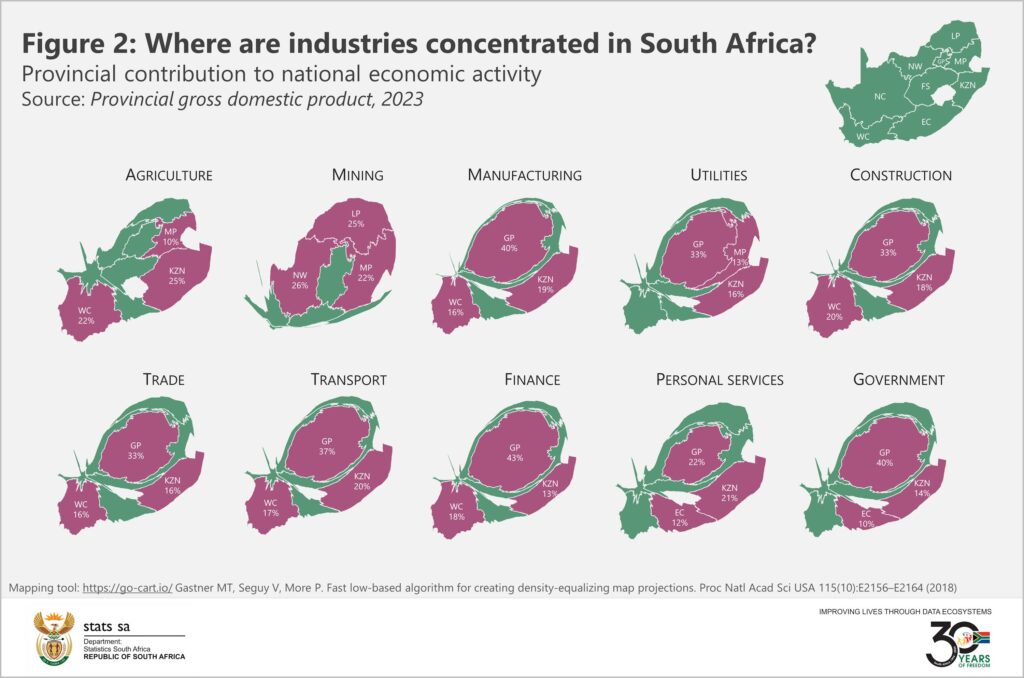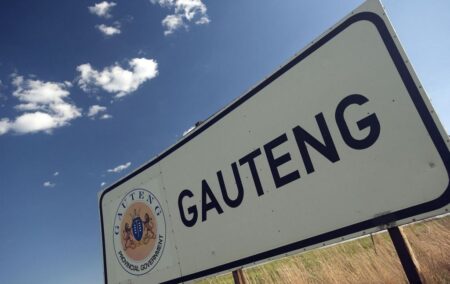On the website of Stats SA you will find a rather remarkable chart. It redraws the map of South Africa by resizing the provinces in accordance with their contribution to various types of economic activity.

The hypertrophied heart at the centre of almost all of these maps is the province of Gauteng: biggest in manufacturing, utilities, construction, trade, transport, finance, personal services and government.
Remarkably, this is despite the province’s minute physical footprint: it accounts for just 1.5% of the country’s land area, is the smallest of all the provinces – but has the largest population, 25.3% of SA’s total.
A large population in a small area means a high population density. Gauteng’s population density of 876 people per square kilometre is over six-and-half times that of KwaZulu-Natal, the second most densely populated province. In fact, Gauteng’s population density is comparable to that of the Gaza Strip and the West Bank, which register at 892 people per square kilometre. You will find even higher population densities in Gauteng’s three metros of Johannesburg, Ekurhuleni and Tshwane, where 87% of the Gauteng population live.
Bubbling cauldron
Gauteng is a bubbling cauldron of migration, contestation and ideas. An August 2024 report by the Centre for Risk Analysis, “Macro Review: Demographics without Dividends”, shows that around 640,000 people are estimated to leave Gauteng between 2021 and 2026. But around 1.4 million are expected to come to the province during the same period, swelling its population by about 750,000 net new residents. (For comparison, the second-ranked province, the Western Cape, is expected to attract around 310,000 net migrants over the same period, including 115,000 from Gauteng and 180,000 from the Eastern Cape.)
The numbers show that Gauteng remains the destination of choice for many people from South Africa and beyond who are in search of a better life. It maintains its historical reputation as a place of migrants, where opportunity beckons and folks from many different walks of life come together.
Gauteng residents cannot afford to be cliquey. They have to be open to encounters with new people and new ideas. The province’s high population density also means that the average Gautenger is likely to have far more interactions with people from other walks of life, who hold different ideas and see the world in different ways.
All of this makes Gauteng the glittering prize in South Africa’s political firmament. It offers greater opportunity for fame and patronage, more resources, more stimulus and greater rewards for politically ambitious leaders. Its economy contributes 33.2% of GDP – more than the next two provinces put together – and is larger than that of Kenya.
Competitive politics
Its politics are among the most competitive in the country, as voters are informed through more news sources and more interactions with fellow residents, and are more willing to test giving a different party their vote than residents in the rural provinces, for example. The traditionally dominant African National Congress (ANC) saw its share of the vote collapse from 50% in 2019 to 35% in 2024.
Gauteng is also where the battle for the soul of the ANC is being fought out. The communist premier of Gauteng, Panyaza Lesufi, is not a fan of the Government of National Unity arrangement which includes the Democratic Alliance (DA). He has made sure to exclude the DA from his provincial government, even though he has to govern through a minority government that controls just 32 of the 80 seats in the legislature. Equally, he has taken care to get the DA out of the municipal government of the three metros.
His intention is to use Gauteng as a test case to demonstrate that an ANC-EFF combination can be stable and effective. It is a combo he can take to the ANC national conference in 2027 and try to sell there: both to position himself for the top job, and to strengthen the anti-GNU wing of the ANC.
If he is successful, and manages to parlay his gamble into growing influence and ultimately control of the ANC, then the prospects for South Africa are dire.
Revolutionary politics
An ANC reoriented on revolutionary policies, inspired by and perhaps in alliance with the EFF or Jacob Zuma’s state capture reunion party, uMkhonto weSizwe, will turbocharge the National Democratic Revolution in South Africa. That will mean more racial polarisation, weaker property rights, wild populist promises (for which Lesufi has already made a name for himself), higher spending, more state interventionism, and a push to nationalise the economy and expropriate private property.
Then South Africa’s development trajectory will turn deeply negative. Investors will flee, growth will crater, unemployment will skyrocket. As South Africa’s economic heart goes into cardiac arrest, secessionists in the Western Cape and KwaZulu-Natal will be strengthened. It will herald the break-up of South Africa as a state, and the evaporation of its potential as a large, integrated and industrialised economy that can generate enough value to lift millions of South Africans out of poverty.
The stakes are high. Parties, individuals and businesses that understand this and want to avoid an NDR outcome for South Africa know that they must allocate a large share of their 2026-focused attention to this province. The implications of who wins extend far beyond the province and far beyond the present moment.
The views of the writer are not necessarily the views of the Daily Friend or the IRR.
If you like what you have just read, support the Daily Friend
Image: SA Tourism, via Flickr, https://www.flickr.com/photos/south-african-tourism/6253216234

